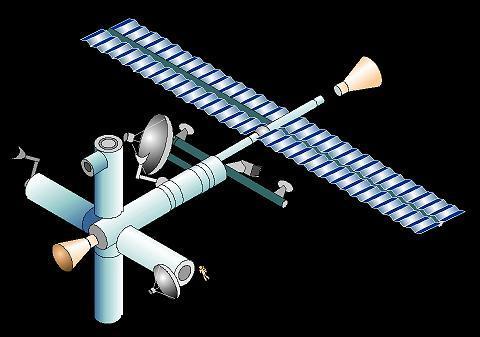
Home - Search - Browse - Alphabetic Index: 0- 1- 2- 3- 4- 5- 6- 7- 8- 9
A- B- C- D- E- F- G- H- I- J- K- L- M- N- O- P- Q- R- S- T- U- V- W- X- Y- Z
Mir-2 KB Salyut

Mir-2 Khrunichev
Credit: NASA
Status: Cancelled 1988.
An article by Y. P. Kornilov of the Salyut Design Bureau entitled "Unknown Polyus" in the journal "Earth and The Universe" threw new light on the original 1981 design for the Mir 2 Space Station. Several designs for Mir 2 have been shown over the years by the Soviets and now by the Russians, but previously it had been impossible to judge which among them were anything more than paper designs.
It had been decided that the Polyus would be the payload for the first launch of the Energia heavy lifter, then scheduled for the fall of 1986. The Soviet space program ran on a five year cycle and Kornilov complained that the Polyus spacecraft had less than the customary five years for development. Kornilov gives no reason for the decision to develop Polyus or for its rushed development. Kornilov then goes on to declare that because of this rush Polyus was created by combining components from several current projects, and that Polyus' central module was adapted from the Mir 2 Space Station. This makes it possible to identify a design for Mir 2 shown by the Soviets in 1987 at the 38th meeting of the IAF in Montreal as being the "real" Mir 2.
An examination of this design reveals several interesting features. Most of the demand for electricity would have been met by solar panels mounted on a docking tunnel. This type of mount would provide 2 degrees of freedom for following the sun. Radiators would have been permanently mounted in the shadow of the solar cells and thus usually remain shaded.
Additional electrical power was to be provided for by a solar dynamic system. The concentrator for this would have been mounted on tracks running around the core's body and thus allowed the concentrator to follow the sun. Movement of the concentrator's mass would have been offset by movement of the mass of the docking arm.
The docking arm would have been used to move modules from the bay of the Buran shuttle, which could dock at a special adapter mounted on the "bottom" of the end of one of the modules. Shuttles would also have been able to dock at the adapter on the end of the docking tunnel, but it kept that normal operations would have been supported by large ballistic capsules.
Spacecraft derived from these ballistic capsules have been recently described in an article by V.V. Pallo of the Salyut Design Bureau on a commercial derivative of the Polyus called the SKIF-DM. These "Orfar" capsules feature extremely large "plastic" heat shields and were launched inexpensively by the Proton expendable launch vehicle.
Only the central core and the solar panels and docking tunnel would have had to have been launched by the Energia. All other components could have been launched by the Proton and operation of the Mir 2 space station did not depend upon the success of the Buran space shuttle.
Mir 2 would have been capable of docking at least four modules in ordinary operation, and thus Mir 2 as configured would have had gravity gradient stabilization. Later Soviet Mir 2 plans called for the Buran shuttle to change out entire modules for material and biological production.
The original Mir 2 project was stopped for budgetary reasons. Yuri Koptev, the current head of the Russian Space Agency, and Yuri Semenov, the current head of NPO Energia, have shown a new and completely different design for Mir 2. An adaptation of the original Mir design, this design was called Mir 1.5 by the cosmonauts, and featured a truss structure. In the event, this was in turn cancelled and replaced by Russian participation in the International Space Station. The space frames of the first modules being provided by Russia for the station were evidently intended originally for Mir 2.
The article also describes the creation of the first payload for the Energia, the Polyus spacecraft. "Polyus" was apparently a test bed for the Soviet response to the US SDI program, the Orbital Weapons Platform. Platforms of this type would have been capable of delivering nuclear warheads from orbit to any point in the US in six minutes. While Kornilov invites the reader to "read between the lines" and points out previous Soviet mis-statements about the Polyus, he was under a security ban which would lead to a 10 years in prison if he reveals (Soviet) "state" secrets. His article claims that the weapons systems tests were peaceful experiments.
According to Kornilov's article, shortly before Polyus' launch President Gorbachev visited the Baikonur Cosmodrome and expressly forbid the on-orbit testing of its capabilities. Kornilov claims that Gorbachev was worried that it would be possible for the West to view this activity as an attempt to create a weapon in space and that such an attempt would compromise the country's leaderships' statements on the USSR's peaceful intent.
Article by Ed Grondine
Family: Soviet Space Stations, Space station, Space station orbit. Country: Russia. Launch Vehicles: Energia. Agency: Korolev bureau. Bibliography: 224.
Back to top of page
Home - Search - Browse - Alphabetic Index: 0- 1- 2- 3- 4- 5- 6- 7- 8- 9
A- B- C- D- E- F- G- H- I- J- K- L- M- N- O- P- Q- R- S- T- U- V- W- X- Y- Z
© 1997-2019 Mark Wade - Contact
© / Conditions for Use